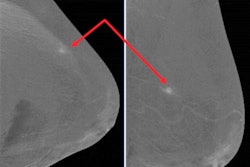
Compared with conventional mammography alone, contrast-enhanced spectral mammography (CESM) catches an additional 7.7% of lesions in recalled women -- and most of these lesions are malignant, Dutch researchers found. The low risks of using CESM as a workup tool make it a valuable addition to breast cancer care, they added.
In this study, more than 800 women recalled from breast cancer screening underwent CESM at follow-up. An experienced breast radiologist reviewed all the exams and identified malignant cases. The research team from the radiology department at Maastricht University Medical Center in the Netherlands spotted 70 lesions detected only by CESM.
"In our opinion, this study showed that the risks of using CESM as a workup tool in recalled women are very low, whilst there is also the advantage of detecting additional tumor foci," they noted.
 Typical example of a CESM exam, which consists of a low-energy image (comparable with full-field digital mammography), followed by the acquisition of a high-energy image (not for diagnostic purpose but used for postprocessing), and the recombined images (showing white areas of contrast captation). In this example, the multifocal invasive breast cancer (arrows) can be appreciated much easier than on the low-energy (mammographic) image of this dense breast. All images courtesy of Dr. Marc Lobbes, PhD.
Typical example of a CESM exam, which consists of a low-energy image (comparable with full-field digital mammography), followed by the acquisition of a high-energy image (not for diagnostic purpose but used for postprocessing), and the recombined images (showing white areas of contrast captation). In this example, the multifocal invasive breast cancer (arrows) can be appreciated much easier than on the low-energy (mammographic) image of this dense breast. All images courtesy of Dr. Marc Lobbes, PhD.Why use CESM?
Since January 2013, the Maastricht University Medical Center has used CESM (Senographe Essential with Senobright upgrade, GE Healthcare) as a clinical tool in evaluating women recalled from screening. Several retrospective studies in the literature show CESM has a higher specificity than mammography and a high negative predictive value.
The researchers of the current study noticed coincidental findings when using CESM at their institution, often finding occult malignancies. But how many malignancies does CESM alone detect? And do the benefits outweigh the risks of increased radiation dose and possible adverse reaction to iodine-based contrast agents? Those are the questions addressed by the researchers (European Journal of Radiology, September 2017, Vol. 94, pp. 31-37).
From December 2012 to December 2015, 839 recalled women underwent CESM in which five minor adverse contrast reactions were observed. Median radiation dose per exam was 6.0 mGy (0.9 mGy to 23.4 mGy). The researchers identified 65 patients with 70 CESM-detected lesions, of which 54.3% (38) proved to be malignant -- most frequently invasive ductal carcinomas. The remaining CESM-detected lesions were benign, predominantly fibroadenomas.
| Detailed breakdown of lesions detected by CESM | |
| Lesion type | No. |
| Fibroadenomas | 13/32 |
| Papillomas | 6/32 |
| Hyperplasia | 4/32 |
| Invasive ductal carcinoma | 30 |
| Invasive lobular carcinoma | 5 |
| Ductal carcinoma in situ | 3 |
No complications occurred during the biopsies of these lesions. Retrospectively, the majority of the lesions were either occult or a "minimal sign" on low-energy CESM images or the screening mammogram, according to the researchers.
"We had the impression that we would occasionally find extra cancers, but, to be honest, this was a little higher than we expected," corresponding author Dr. Marc Lobbes, PhD, wrote in an email to AuntMinnieEurope.com. "It confirmed our theory that we should use CESM in these women."
The researchers noted the retrospective study design made it hard to tell whether lesions detected only by CESM would have been overlooked by the screening radiologists, or whether they would have been detected during routine workup. Regardless, CESM-based workup should be considered, according to the study authors.
"Our lesion conspicuity analysis showed that the majority of CESM-only lesions were, in retrospect, occult or visible as 'minimal sign,' meaning they did not raise any concerns on conventional mammographic images but became suspicious by their ability to enhance after contrast administration," they wrote.
Also, a greater proportion of CESM-detected lesions were visible on the low-energy images than on full-field digital mammography (FFDM), implying that the low-energy images show improved lesion detection compared with FFDM. This was presumably caused by the very small amount of iodine contrast already in the breast lesion when acquiring the low-energy images, they added.
Future research
In terms of future research, the group is commencing with the Rapid Access to Contrast-Enhanced Spectral Mammography (RACER) study in January for women recalled from screening.
"We retrospectively observed for a number of study aims that CESM is superior to FFDM in this patient category," Lobbes wrote. "However, we need a prospective randomized controlled trial to gain the highest level of evidence and to convince national guidelines to include this approach."
He and his colleagues will randomize women to either undergo standard care with conventional mammography via their general practitioner or breast cancer clinic or have immediate access to a CESM exam by a radiologist.
"We hypothesize this new approach based on CESM is more accurate, more patient-friendly (short time span to develop anxiety and stress), and more cost-efficient," Lobbes wrote.
The project will run for four years and is supported by the ZonMw Institute (The Netherlands Organisation for Health Research and Development).



















